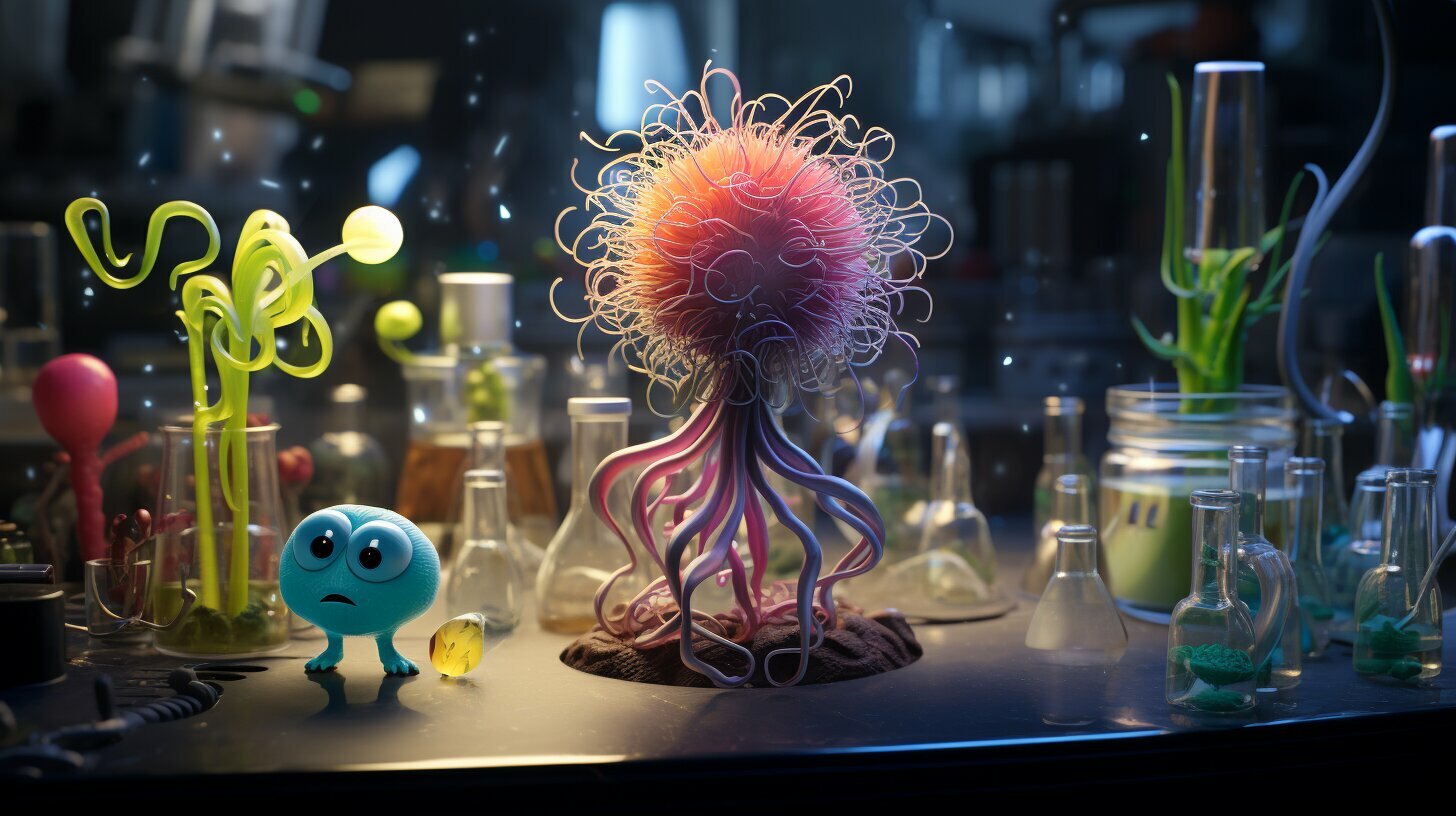Can Plants Get Diseases?, I’ve heard many different questions, but one that always sticks out is whether plants can get diseases. It’s a good question and one that is worth exploring. The truth is that plants are just as susceptible to diseases as humans and animals. In this article, I’ll dive into the world of plant pathogens and their impact on our beloved leafy friends.
Key Takeaways:
- Plants can get diseases just like humans and animals
- In this article, we’ll explore different types of plant diseases, their signs, and management strategies
- Research plays an important role in understanding and combating plant diseases
- Plant diseases can have a significant impact on ecosystems and food security
- Proactive measures can be taken to promote plant health and prevent diseases from occurring
Understanding Plant Diseases
Plants, just like humans, can fall prey to diseases. Some of the common plant diseases include powdery mildew, blight, and black spot. Preventing these diseases starts with having the knowledge and understanding of how they operate.
Common Plant Diseases
Identification is the first step in controlling or treating plant diseases. Some of the common plant diseases include:
| Disease Name | Description |
|---|---|
| Powdery mildew | A fungal disease that creates a white, powdery coating on leaves and stems. |
| Blight | A fungal disease that causes rapid death of plant tissues, particularly on leaves and fruits. |
| Black spot | A fungal disease that creates circular spots with black margins on leaves, eventually causing them to fall off. |
Preventive measures are key to keeping plants healthy. These measures include:
- Planting disease-resistant varieties.
- Practicing proper watering techniques.
- Maintaining appropriate soil pH and fertility levels.
- Sanitizing tools and equipment to limit the spread of diseases.
Plant Diseases Prevention and Treatment
There are various methods for preventing and treating plant diseases. Some of the most common approaches include:
- Using cultural practices such as crop rotation, pruning, and planting in favorable conditions.
- Implementing chemical treatments such as fungicides to kill and prevent the growth of pathogens.
- Using biocontrol agents such as beneficial insects to target and eliminate harmful organisms.
- Employing genetic modification to produce disease-resistant plants.
It is important to note that prevention is always better than cure, and early detection is crucial in controlling and treating plant diseases. Regularly monitoring plants for signs of diseases, such as yellowing leaves, distorted growth, or dropped fruits, can help identify and solve issues before they become severe.
Identifying Plant Diseases
As I mentioned earlier, identifying the signs of plant diseases is crucial for effective management. There are several visual cues and other indicators to look out for when examining plants for disease presence.
Leaf discoloration: One of the most common signs of plant diseases is discoloration of the leaves. This may include yellowing, browning, or blackening of the leaves.
Leaf spots: Another visual indicator is the presence of spots on the leaves. These spots may be different colors and sizes depending on the disease.
Wilting: If a plant appears to be wilting or drooping, this could indicate a problem with its root system or a soil-borne disease.
Stunted growth: Plants suffering from disease may also show stunted growth, with smaller leaves or fruits than healthy plants of the same age.
Mushy stems or roots: If the stem or root of a plant appears mushy or discolored, this may indicate a bacterial or fungal disease.
It’s important to note that these signs may not always indicate a disease, as certain environmental factors can also cause similar symptoms. However, if several of these signs are present, it’s best to take action and consult a plant expert for diagnosis.
Managing Plant Diseases
Once a plant disease has been identified, it’s important to take immediate action to prevent further spread and manage the impact. There are several strategies that can be effectively employed to control and manage plant diseases. These strategies can be broadly categorized into cultural, physical, and chemical methods.
Cultural Methods
Cultural methods involve modifying the environment in which the plant is growing to make it less hospitable for the pathogen. This can include practices such as crop rotation, intercropping, and planting resistant cultivars. By rotating crops, pathogens that are specific to a particular crop are deprived of a host and unable to continue to spread. Intercropping involves planting different crops in close proximity, which can help reduce the incidence of disease by disrupting the life cycle of the pathogen. Planting resistant cultivars can also be an effective way to prevent disease, as they have natural resistance to specific pathogens.
Physical Methods
Physical methods involve physically removing or destroying infected plant material. This can include pruning, which removes infected branches or leaves, and removing infected plants entirely. Proper sanitation practices, such as cleaning tools and removing fallen leaves and debris, can also help prevent the spread of disease.
Chemical Methods
Chemical methods involve the use of pesticides or fungicides to treat plant diseases. While these treatments can be effective in controlling disease, they should be used only as a last resort, as they can have negative impacts on the environment and on human health. It’s important to follow proper safety precautions and to carefully read and follow all label instructions when using chemical treatments.
Overall, effective management of plant diseases requires a combination of cultural, physical, and chemical methods. By implementing these strategies, we can ensure the health and vitality of our plants and prevent the spread of disease.
Researching Plant Diseases
Research plays a crucial role in understanding and combating plant diseases. Scientists, researchers, and agricultural experts focus on developing new technologies, identifying resistant varieties of plants, and discovering new methods to control plant diseases.
In recent years, there has been a significant increase in plant disease research, with a particular focus on learning more about the genetic pathways that enable plants to resist or succumb to pathogens.
Scientists have developed new tools to study plant diseases, including advanced molecular techniques that allow for the identification of specific genes involved in disease resistance. These tools, coupled with the development of new genomic resources, have enhanced our understanding of how plants interact with their environment and how they respond to disease-causing organisms.
One of the most promising areas of research in plant pathology is the use of biotechnology to create genetically modified plants that are resistant to disease. Researchers are using gene-editing techniques, such as CRISPR/Cas9, to develop new varieties of crops that are resistant to specific diseases, improving crop yields and enhancing food security.
Overall, ongoing research into plant diseases is crucial to protecting our plants and ensuring a sustainable future for agriculture. With new technology, innovative methods, and a growing body of knowledge, we can combat plant diseases and promote healthy and robust plants.
The Impact of Plant Diseases
As a plant lover, I’m sure you’re aware of the beauty and benefits that plants bring to our world. Unfortunately, plant diseases can have a significant impact on our environment and economy.
Economically, plant diseases can cause significant losses for farmers and growers, affecting crop yield and quality. This can lead to higher prices for consumers and even contribute to food scarcity in some regions. Furthermore, plant diseases can disrupt ecosystems and lead to the decline or extinction of plant species, impacting our biodiversity and the health of our planet.
Research shows that many plant diseases result from human activities and practices. Climate change, increased global travel and trade, and the overuse of pesticides and fertilizers all contribute to the spread of plant diseases. By taking proactive measures to promote plant health and prevent disease, we can reduce the impact of plant diseases on our world.
- Practice integrated pest management: This approach involves combining multiple strategies to control pests and diseases, including natural methods and chemical treatments.
- Plant disease-resistant crops: By selecting plant varieties that are naturally resistant to common diseases, we can reduce the need for chemical treatments and promote plant health.
- Rotate crops: Rotating crops from year to year can prevent the build-up of pathogens in the soil, reducing the risk of disease.
By implementing these and other practices to promote plant health, we can help to reduce the impact of plant diseases on our world. Ongoing research in the field of plant pathology will also continue to enhance our knowledge and ability to protect our leafy friends.
Promoting Plant Health
As plant diseases can have detrimental effects on plant growth and development, taking proactive measures to promote plant health is essential. Here are some practical tips to keep your plants healthy:
- Watering: Water plants regularly, ensuring the soil is moist but not saturated. Avoid overwatering as it can lead to root rot and other fungal diseases.
- Soil Management: Ensure that soil is well-draining and rich in nutrients. Use organic matter such as compost or manure to boost soil fertility.
- Nutrition: Provide plants with the necessary nutrients for healthy growth. Use fertilizers that are specific to the needs of the plants.
- Avoid Crowding: Do not overcrowd plants, as it can increase the risk of disease spread. Adequate spacing allows air circulation and reduces the likelihood of fungal growth.
- Proper Pruning: Regular pruning helps to remove diseased or damaged plant parts, preventing the spread of infections.
By following these tips and maintaining a healthy environment for your plants, you can prevent diseases from occurring and ensure the longevity of your beloved greenery.
Conclusion
In conclusion, I have learned that plants are susceptible to diseases just like humans and animals. By understanding the different types of plant diseases, identifying the signs, and implementing effective management strategies, we can ensure the health and vitality of our plants.
It’s clear that ongoing research in the field of plant pathology is crucial in combating diseases that threaten our plants. By staying informed of breakthroughs and developments in this field, we can better protect our leafy friends.
It’s important to remember that plant diseases have broader impacts beyond just our houseplants or gardens. They can have economic consequences, disrupt ecosystems, and even impact food security. By implementing proactive measures to promote plant health, such as proper watering and soil management, we can help prevent diseases from occurring in the first place.
In the end, taking care of our plants is not only beneficial for their own health and wellbeing, but also for our own enjoyment and the health of our planet. So let’s continue to learn, grow, and care for our leafy friends.
FAQ
Q: Can plants get diseases?
A: Yes, plants can get diseases. Just like humans and animals, plants are susceptible to various pathogens that can cause diseases. Plant diseases can be caused by bacteria, fungi, viruses, and other microorganisms.
Q: What are some common plant diseases?
A: Some common plant diseases include powdery mildew, leaf spot, root rot, and blight. These diseases can affect different parts of the plant, such as leaves, stems, roots, and fruits.
Q: How can I prevent plant diseases?
A: To prevent plant diseases, it is important to maintain proper plant care practices. This includes providing adequate sunlight, water, and nutrients to your plants. Avoid overwatering, overcrowding, and planting susceptible plants in the same area. Regularly inspect your plants for any signs of disease and promptly remove any infected plant material.
Q: How can I treat plant diseases?
A: The treatment of plant diseases depends on the specific disease and its severity. In some cases, pruning and removing infected plant parts may be enough to control the disease. Fungicides, insecticides, and other chemical treatments can also be used. It is important to follow the instructions carefully and choose the appropriate treatments for your specific plant disease.
Q: How can I identify plant diseases?
A: There are several signs that can help identify plant diseases. Common indicators include wilting, yellowing or browning of leaves, spots or lesions on leaves, stunted growth, and abnormal growth patterns. It is also helpful to research specific plant diseases and their symptoms to accurately identify the issue.
Q: What is the impact of plant diseases?
A: Plant diseases can have various impacts. They can lead to reduced crop yields, economic losses for farmers, and disruption of ecosystems. Plant diseases can also affect food security and have negative environmental consequences. It is important to address plant diseases to ensure the health of plants and the sustainability of agricultural practices.
Q: How can I promote plant health?
A: Promoting plant health involves practicing good plant care. This includes providing optimal growing conditions, such as proper sunlight, water, and nutrients. Regularly inspecting plants for signs of disease and promptly addressing any issues is also important. Additionally, promoting biodiversity in your garden can help prevent the spread of plant diseases.
Q: Any final thoughts on plant diseases?
A: In conclusion, plant diseases are a real concern, and it is essential to understand how they can affect our plants. By being proactive in preventing and managing plant diseases, we can ensure the health and vitality of our leafy friends. Ongoing research and knowledge-sharing in the field of plant pathology will continue to enhance our ability to protect plants from diseases.





Pingback: Exploring the Question: Are Plants Asexual?
Pingback: Unlocking Plant Uses for Vinegar: A Gardener's Guide
Pingback: Are Plants Unicellular or Multicellular? Discover the Truth